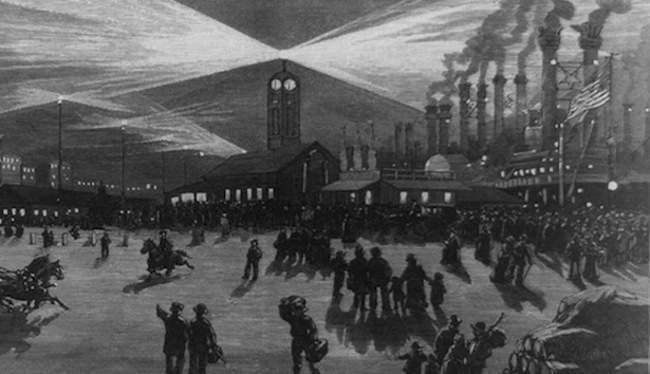The Moon Towers of Austin Texas
EVER seen a moon tower? In the 19th Century moon towers were “the future of municipal lighting was glowing orbs suspended high above cities”:
Aurora, Illinois — ironically named only in retrospect — was one of the early places to experiment with artificial moonlight. The town contracted with Charles Francis Brush, an inventor and an entrepreneur and one of Edison’s chief competitors in the race to electrify America. In his wonderful book The Age of Edison: Electric Light and the Invention of Modern America, Ernest Freeberg describes what it’s like to be a town lit, suddenly, by imitation moons. Brush installed his enormous lights, Freeberg notes, via six iron towers studded across Aurora — structures “rising like gigantic pencils over the city’s rooftops.” Stretching high above the skyline, Brush arc lamps provided intense light to the areas directly below them. They also, Freeberg writes, “bathed the surrounding fields and ‘lonely outskirts’ of the city with something like ‘full summer moonlight.’”
It was bright – too bright:
The powerful illumination from one of Aurora’s manmade moons could be easily blocked by anything that got in its way, be it a tree or a building or a human body. People complained about the disorienting shadows cast by the arc lights, Freeberg notes. They complained about the jarring effects of walking from day to night in the space of a few footfalls. Brush, aware of this problem, focused his moon tower efforts on Midwestern cities that had the twin virtues of being both geographically flat and designed on a grid, thus mitigating the problem of the angles.
You can see them in Austin, Texas:
The “artificial moonlight” was originally prduced by a then relatively new device called a carbon arc lamp. These original carbon arc lamps illuminated a circle approximately 3,000 feet in diameter with a blue-white light. The light was intended to be bright enough that you could read an ordinary pocket watch on midnight of even the darkest of nights. The city electric department employed one person whose sole responsibility was to maintain the carbon arc lamps and light the towers each day. In 1923, the city replaced the carbon arc lamps with incandescent bulbs and switches were installed at the base of each tower. During World War II, the need to quickly black out the city dictated that the switches be replaced with one central switch. The towers now use 6,400-watt mercury vapor bulbs and the illumination is fully automated.
Party at the moon tower:
Posted: 10th, March 2013 | In: Technology Comment | TrackBack | Permalink




